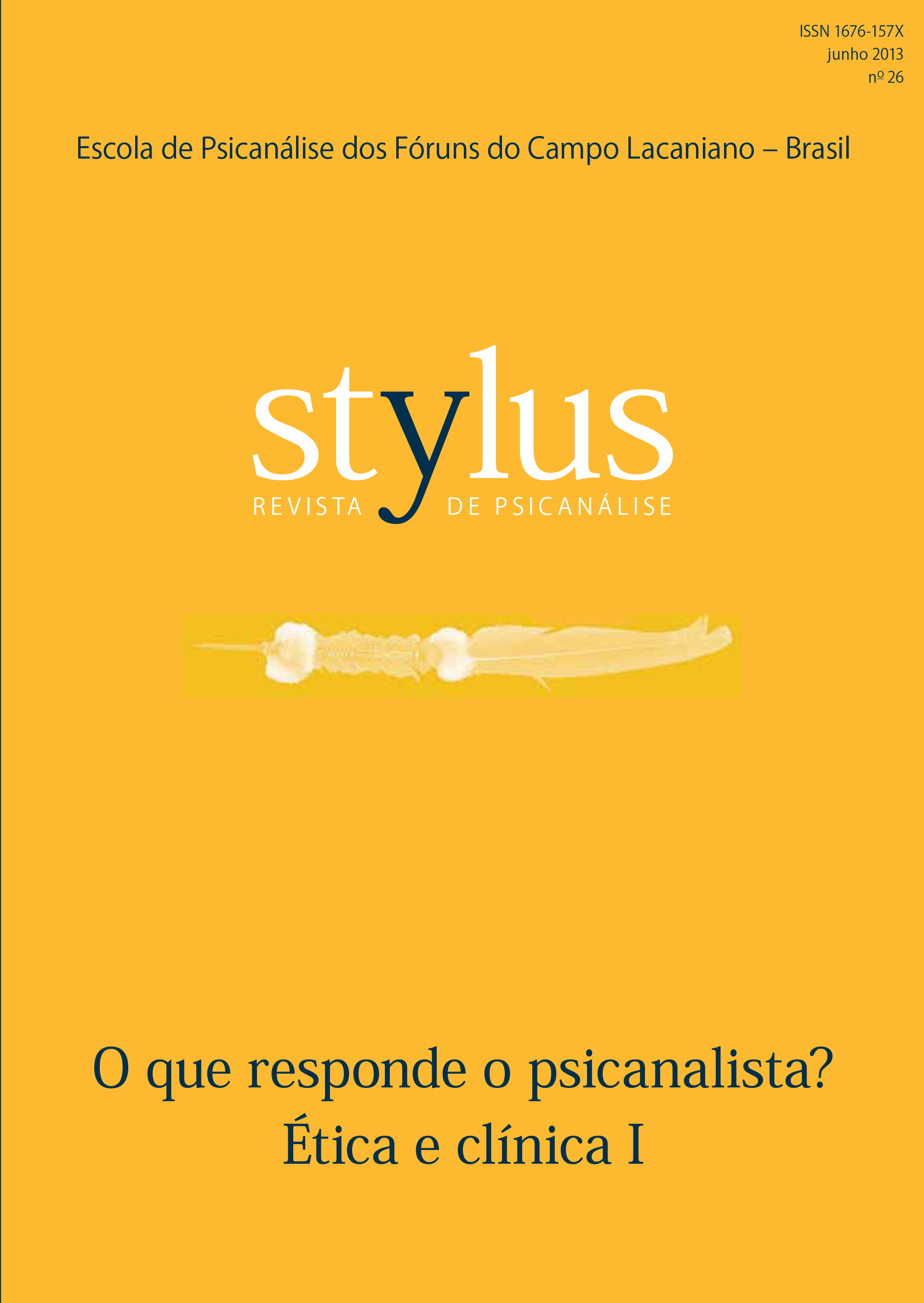A oferta, a demanda e... a resposta
DOI:
https://doi.org/10.31683/stylus.vi26.748Keywords:
transfer, interpretation, saying, apofantic saying, said, cultureAbstract
Departing from the question: “What does the psychoanalyst answer?” – the title of the VII Meeting of the International Forums and the School of Psychoanalysis of the Forums of the Lacanian Field – the author situates what is from the order of the offer, demand, and the response in a psychoanalysis. The analyst’s response is not from the recording of the interlocution, the offer, before the demand and distinct from the response, it is the first step of the analytical act, its beginning. Distinguishing the current position of the analysts from those by Freud and Lacan, it is asked: How to pass to the act, in each case, the offer already in the culture? She answers the question by calling attention to the difference between knowledge and the ‘knowing how to do’ of the analyst, a fundamental distinction that leads Lacan into saying that the analyst is responsible only at the limit of its ‘knowing how to do’. The author returns to the discussion about the response, that one to be made to the transference demand that aims to produce analysis. She also highlights Lacan’s formulation in Television, which says that it is about clearing up the unconscious of each one is subject, that is, to produce the transference fall, to highlight its impasse and its deception, as well was the mirage of truth. This operation unfolds the response in two, being interpretation what qualifies the final response. The author emphasizes in the development of her text the common reach of various formulations Lacan provides the term interpretation with, since the one which aims at a real, is never conciliatory, there is no universal of interpretation. With the idea that interpretation is a “saying no”, the author utilizes Lacan’s statement “saying is an act,” pointing to the double dimension of speech, the said and the ‘to be said’, which will unfold itself relying on various references to Lacan on this topic. She also evokes two real effects in the sense that they are written by analytical saying, the real sense of the symptom and the real sense of the saying of the analyzing demand. Finally, she highlights the apofantic saying of interpretation, proving to be a possible way of bringing a new look over the end of the analysis. The author concludes her elaboration with observations about the possible place of an analytical response to the current civilization.
Downloads
References
Escritos. Rio de Janeiro: Jorge Zahar Editor, 1998, pp. 238-324.
__________. (1957). A instância da letra no inconsciente ou a razão desde Freud.
In: Escritos. Tradução Vera Ribeiro. Rio de Janeiro: Jorge Zahar Editor, 1998,
pp. 238-324.
__________. (1967). O engano do Sujeito suposto Saber. In: Outros escritos. Rio
de Janeiro: Jorge Zahar Editor, 2003, pp. 329-340.
__________. (1967). Proposição de 9 de outubro de 1967 sobre o psicanalista
da Escola. In: Outros escritos. Rio de Janeiro: Jorge Zahar Editor, 2003a, pp.
248-264.
__________. (1969). O ato psicanalítico (resumo). In: Outros escritos. Rio de Janeiro:
Jorge Zahar Editor, 2003, pp. 371-382.
__________. (1972). O aturdito. In: Outros escritos. Rio de Janeiro: Jorge Zahar
Editor, 2003, pp. 448-497.
__________. (1972). Televisão. In: Outros escritos. Rio de Janeiro: Jorge Zahar
Editor, 2003a, pp. 508- 543.
__________. (1973). Posfácio ao Seminário 11. In: Outros escritos. Rio de Janeiro:
Jorge Zahar Editor, 2003, pp. 503-507.
__________. (1973). Introdução à edição alemã de um primeiro volume dos
Escritos In: Outros escritos. Rio de Janeiro: Jorge Zahar Editor, 2003a, pp. 550-
556.
__________. (1973). ...ou pior (resumo). In: Outros escritos. Rio de Janeiro: Jorge
Zahar Editor, 2003b, pp. 544-549.
__________. (1973). Nota italiana. In : Outros escritos. Rio de Janeiro : Jorge
Zahar Editor, 2003c, pp. 311-315.
__________. (1973-1974). Le Séminaire: Livre 21 – Les non dupes errent, inédito.
__________. (1974-1975). Le Séminaire : Livre 22 – R.S.I., inédito.
__________. (1975). Conférences à la Yale University In: Scillicet, 6/7.
__________. (1976). Prefácio à edição inglesa do Seminário XI. In: Outros escritos.
Rio de Janeiro: Jorge Zahar Editor, 2003, pp. 567-569.
__________. (1976-1977). Le Séminaire: Livre 24 – L’insu que sait de l’une bévue
s’aile à mourre, inédito.
Downloads
Published
How to Cite
Issue
Section
License
Ao encaminhar os originais, os autores cedem os direitos de publicação para STYLUS.
Os autores assumem toda responsabilidade sobre o conteúdo do trabalho, incluindo as devidas e necessárias autorizações para divulgação de dados coletados e resultados obtidos, isentando a Revista de toda e qualquer responsabilidade neste sentido.



